MRDucks2
Member
From the previous items we posted under our Novice Trials of Liquid Diamonds, Chuck (dalecamino) and I did not like the long time required for LD blanks to actually cure hard enough to turn and polish.
We had learned that Aldax Enterprises a Liquid Diamonds vendor in New South Wales states on their website,
"This product can be mixed at a ratio of 65% hardener. This will create a super clear bubble free finish. Mixing by weight (100:65 resin/hardener). Your pieces will cure faster, harder, and have less bubbles than the 2-1 mixture. This mixing procedure is not recommended on large pieces above 2".
So, with Chucks approval (since he brought the Liquid Diamonds to my shop) I decided to run a test and see how changing the mix ratio between parts A and B affected the cure of the blanks.
I picked 4 ratios, the original 2:1, 1.8:1, 1.7:1 and 1.54:1 to see what the result was.
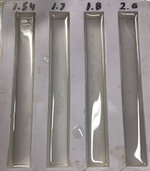
One of each ratio was mixed and poured into each of the 4 voids of a 4 blank mold.
They were placed in a pot under 60psig and left for 22 hours (no reason for 22, that just happened to be when I got back to the shop. At that point they were removed from the pot and the mold. (Mold had been sprayed with Stoner Thermoset Epoxy Mold Release)
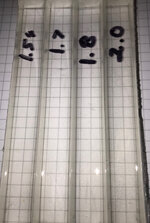
They all looked good and were pliable, which we know is normal for Liquid Diamonds out of the pot. I checked each with my 2.5 pound weight to see how much they would sag under the weight right out of the pot:
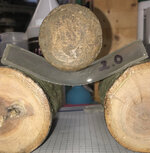
The standard 2:1 ratio
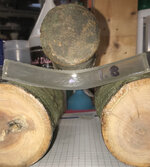
A ratio of 1.8:1
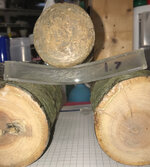
Ratio of 1.7:1
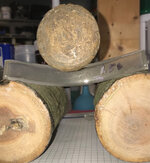
The ratio of 1.54:1
There was some difference between the 2.0:1 and 1.8:1 but you can see the greater difference at 1.7:1. With my crude methods, there didn't seem to be a lot of difference between the 1.7:1 and the 1.54:1.
I think the biggest difference shows up a day later.
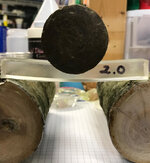
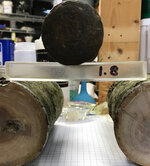
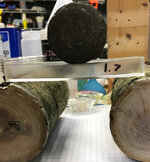
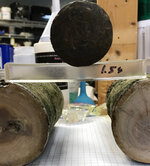
From fiddling around with the blanks, bending, squeezing, pinching, marking, it appears that for this test the 1.7:1 ratio produces in 24 hours out of the pot a blank that has very, very similar properties of the blank from the earlier test at 6 days out of the pot.
Here is that blank under the weight at 6 days for comparison:
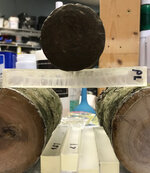
Obviously results may vary based on your temperatures, humidity, etc. I think the key is that if you do like/want to use Liquid Diamonds and don't want to wait "4 or 5 days" before it is completely cured, you can modify the ratio to increase the hardener and thereby decrease the cure time.
Doesn't take much and see what works best for you.
- Happy Turning!
Sent from my iPhone using Penturners.org mobile app
We had learned that Aldax Enterprises a Liquid Diamonds vendor in New South Wales states on their website,
"This product can be mixed at a ratio of 65% hardener. This will create a super clear bubble free finish. Mixing by weight (100:65 resin/hardener). Your pieces will cure faster, harder, and have less bubbles than the 2-1 mixture. This mixing procedure is not recommended on large pieces above 2".
So, with Chucks approval (since he brought the Liquid Diamonds to my shop) I decided to run a test and see how changing the mix ratio between parts A and B affected the cure of the blanks.
I picked 4 ratios, the original 2:1, 1.8:1, 1.7:1 and 1.54:1 to see what the result was.

One of each ratio was mixed and poured into each of the 4 voids of a 4 blank mold.
They were placed in a pot under 60psig and left for 22 hours (no reason for 22, that just happened to be when I got back to the shop. At that point they were removed from the pot and the mold. (Mold had been sprayed with Stoner Thermoset Epoxy Mold Release)

They all looked good and were pliable, which we know is normal for Liquid Diamonds out of the pot. I checked each with my 2.5 pound weight to see how much they would sag under the weight right out of the pot:

The standard 2:1 ratio

A ratio of 1.8:1

Ratio of 1.7:1

The ratio of 1.54:1
There was some difference between the 2.0:1 and 1.8:1 but you can see the greater difference at 1.7:1. With my crude methods, there didn't seem to be a lot of difference between the 1.7:1 and the 1.54:1.
I think the biggest difference shows up a day later.




From fiddling around with the blanks, bending, squeezing, pinching, marking, it appears that for this test the 1.7:1 ratio produces in 24 hours out of the pot a blank that has very, very similar properties of the blank from the earlier test at 6 days out of the pot.
Here is that blank under the weight at 6 days for comparison:

Obviously results may vary based on your temperatures, humidity, etc. I think the key is that if you do like/want to use Liquid Diamonds and don't want to wait "4 or 5 days" before it is completely cured, you can modify the ratio to increase the hardener and thereby decrease the cure time.
Doesn't take much and see what works best for you.
- Happy Turning!
Sent from my iPhone using Penturners.org mobile app
Last edited:
